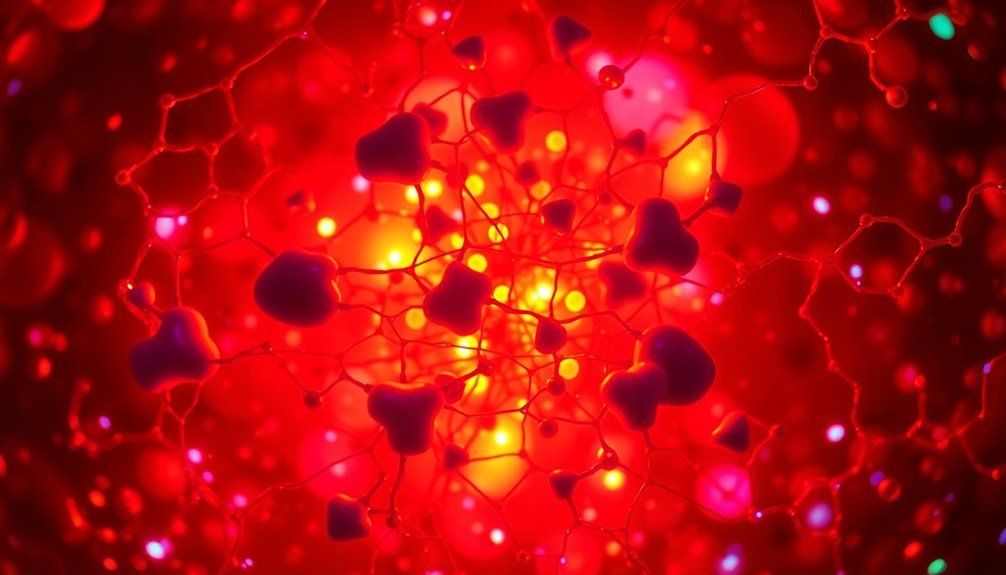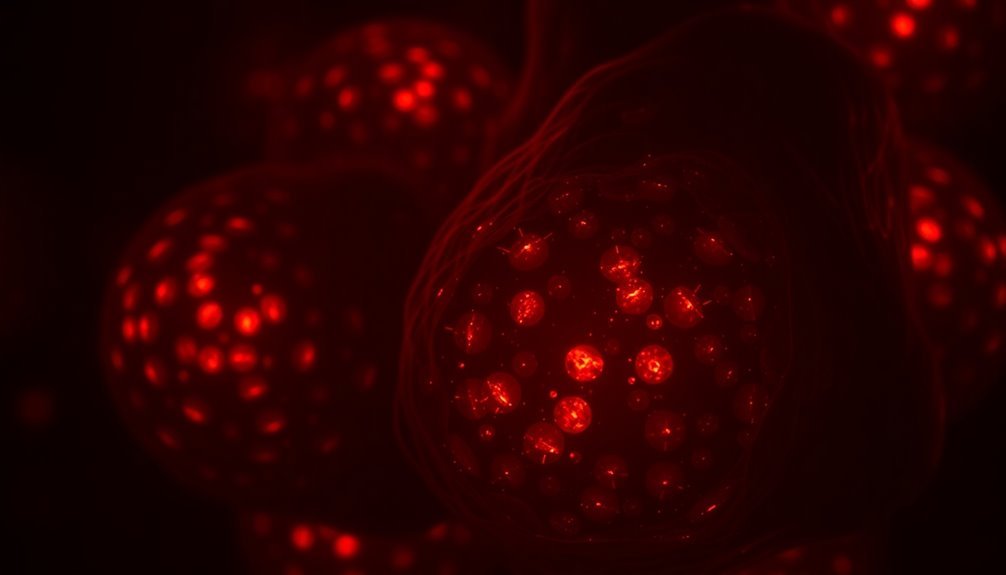Your cells harbor a remarkable protein complex that's hungry for deep red and near-infrared light wavelengths between 700-1000 nanometers. Cytochrome C oxidase (CCO) acts as your cellular powerhouse's light receptor, using these specific wavelengths to boost energy production. You'll find this protein nestled in your mitochondria, where it efficiently converts light energy into cellular fuel through a process called photobiomodulation. When CCO absorbs these deep wavelengths, it enhances ATP production, accelerates healing, and supports overall cellular health. There's much more to discover about how this fascinating protein complex dances with light to power your life.
The Light-Loving Cellular Powerhouse

While many cellular processes occur in darkness, Cytochrome C Oxidase (CCO) plays a fascinating dual role as both an energy producer and a light-responsive enzyme. You'll find this complex molecular machine at work in your mitochondria, where it's essential for cellular respiration and energy production.
CCO's powerhouse capabilities stem from its intricate structure of multiple subunits, featuring two hemes and two copper molecules that work together seamlessly. Its assembly requires over 30 chaperone proteins to build the complete enzyme complex. You can think of it as a molecular pump that's constantly at work, transferring electrons from cytochrome c molecules to oxygen while simultaneously pumping protons across the membrane.
What makes CCO particularly remarkable is its sophisticated electron transfer process. When you look at its core mechanism, you'll see it can handle four electrons from cytochrome c molecules, converting oxygen and protons into water molecules.
This process isn't just about making water – it's creating a proton gradient that's essential for ATP production. The enzyme's binuclear center, comprising cytochrome a3 and Cu B, orchestrates this intricate dance of electrons, making it one of your cells' most efficient energy-producing systems.
Deep Red Wavelengths Matter
CCO's remarkable properties extend beyond its role in cellular respiration – it's also highly responsive to specific wavelengths of light.
You'll find that deep red and near-infrared wavelengths between 700 and 1,000 nm can penetrate your tissues effectively, reaching important targets like your brain. This penetration occurs because hemoglobin and water don't strongly absorb light in this spectrum. The cytochrome c oxidase enzyme enhances ATP synthesis by dissociating inhibitory nitric oxide.
What makes this interaction particularly fascinating is CCO's copper centers, which respond differently to various wavelengths. You'll notice that:
- 750 nm and 940 nm wavelengths inhibit CCO activity, offering neuroprotection
- 810 nm stimulates CCO and increases ATP production
- 630 nm, 700 nm, and 810 nm are substantially attenuated by brain tissue
- Different brain layers respond uniquely to these wavelengths
- The effects can be either stimulatory or inhibitory, depending on the wavelength chosen
When you're considering therapeutic applications, this wavelength specificity becomes vital. You can target specific outcomes by selecting the right wavelength – whether you're aiming to protect neurons during injury or boost energy metabolism for healing.
This precise control makes near-infrared light therapy a powerful tool for various medical applications.
Energy Production Through Light

Three key processes drive light-based energy production in your cells through cytochrome c oxidase.
First, your cells absorb red to near-infrared light wavelengths (700-1000 nm) through the copper centers in cytochrome c oxidase. These chromophores are specifically designed to capture photons in this range, which can effectively penetrate deep into your brain tissue.
Second, once the light's absorbed, it triggers a fascinating cascade of events in your mitochondria. The absorbed photons up-regulate cytochrome c oxidase activity, enhancing its redox state and boosting oxidative phosphorylation. This leads directly to increased ATP synthesis, which means more energy for your cells. This enhanced cellular energy production activates specific kinases that trigger calcium release within the cells.
The wavelength specificity is critical to this process. You'll get the best energy production boost at around 810 nm, while wavelengths of 750 nm and 950 nm actually inhibit the enzyme's activity. This precise wavelength dependency isn't random – it's based on cytochrome c oxidase's specific absorption spectrum.
Understanding this mechanism has opened new doors in therapy, as you can now target specific cellular responses by choosing the right wavelength of light for your treatment needs.
Healing Beyond Visible Spectrum
Deep within your body's tissues, near-infrared light accomplishes what visible light can't – profound healing through photobiomodulation therapy. When near-infrared wavelengths between 700 and 1,000 nm penetrate your tissues, they directly interact with cytochrome C oxidase (CCO), the primary photon acceptor in your cells.
You'll find this healing process particularly effective because:
- NIR light can reach deep tissues, including your brain, where visible light can't penetrate
- Your CCO's copper centers actively absorb these specific wavelengths, triggering cellular repair
- Different wavelengths serve unique purposes – 810 nm stimulates healing while 750 nm offers neuroprotection
- The therapy boosts ATP production and energy metabolism in your neurons
- Treatment can be precisely tailored to your specific healing needs through wavelength optimization
You're experiencing a sophisticated biological response when NIR light activates CCO. This activation improves wound healing, supports neurological recovery, and enhances cellular energy production. The addition of a ZnS shell coating significantly improves the stability and effectiveness of the treatment.
Scientists can now map these effects through quantitative CCO histochemistry, measuring exactly how your tissues respond to different wavelengths. This precise understanding allows for increasingly effective therapeutic protocols tailored to specific healing requirements.
Mitochondrial Dance With Photons

Inside your mitochondria, a remarkable molecular dance unfolds when photons of near-infrared light meet cytochrome C oxidase (CCO). This critical enzyme, nestled within your mitochondrial inner membrane, avidly absorbs light wavelengths between 700 and 1,000 nanometers, triggering a cascade of cellular events that boost your energy production.
When near-infrared light penetrates your tissues, CCO's copper centers capture these photons, changing the enzyme's redox state. This interaction enhances your mitochondria's ability to convert oxygen into water and produce ATP, your cells' primary energy currency. You'll find this process particularly effective at specific wavelengths, such as 810 nm, which ideally stimulates CCO activity. This stimulation leads to the release of nitric oxide, promoting improved blood flow and tissue oxygenation.
What's fascinating is that your body's tissues, including your brain, allow near-infrared light to pass through them with minimal interference from water or hemoglobin. This means photobiomodulation can reach deep into your tissues, where CCO awaits.
The light's interaction with CCO doesn't just boost energy production – it also influences your mitochondrial membrane potential and reactive oxygen species levels, creating a therapeutic effect that can aid in healing and cellular repair.
Frequently Asked Questions
Can Excessive Photobiomodulation Therapy Cause Damage to Cytochrome C Oxidase?
Yes, you'll find that excessive photobiomodulation can damage cytochrome c oxidase by inhibiting its activity, causing harmful ROS bursts, increasing oxidative stress, and triggering mitochondrial dysfunction through wavelengths like 750nm and 950nm.
How Do Seasonal Changes Affect Natural Photon Absorption by CCO?
While you'll notice seasonal changes in visible light absorption, CCO's NIR absorption remains relatively stable year-round. Summer months give you more available photons, but CCO's deep tissue absorption capability stays consistent.
Does CCO Light Absorption Capacity Decrease With Aging?
Yes, your CCO's light absorption capacity does decrease with aging, but you can counteract this decline through photobiomodulation therapy, which helps restore CCO activity to levels similar to younger individuals.
Are There Genetic Variations That Affect Cco's Response to Specific Wavelengths?
Yes, you'll find genetic variations in CCO genes (like COX1-3) can affect how well your cells respond to specific wavelengths, though there's limited direct research on these variations' impact on photobiomodulation effectiveness.
Can Dietary Factors Enhance or Inhibit Cco's Photon Absorption Capabilities?
Your diet won't directly affect CCO's ability to absorb photons, but proper nutrition can enhance overall CCO function. While antioxidants and minerals support mitochondrial health, they don't change CCO's wavelength absorption properties.
In Summary
You've discovered how cytochrome c oxidase's affinity for deep red and near-infrared light isn't just a scientific curiosity – it's your cells' secret weapon for energy production. When you expose your body to these specific wavelengths, you're activating a natural healing response at the mitochondrial level. By understanding this relationship between light and cellular function, you're tapping into powerful therapeutic potential for regeneration and recovery.





Leave a Reply